#assamese calendar
Explore tagged Tumblr posts
Text
Assamese people are living in the middle ages
No really
It's year 1430 according to the Assamese calendar
19 notes
·
View notes
Text
List of gender neutral/non binary names from mythology! (global mythology) (Part 1!)
Hope this helps someone! (Added some relative links/definitions from 'Behind the Name'. :D)
If you have any suggestions of what I should post next feel free to send me an ask!! :D
Ailbhe (Irish): From Old Irish Ailbe, possibly derived from the old Celtic root *albiyo- "world, light, white" or Old Irish ail "rock". In Irish legend this was the name of a female warrior of the Fianna. It was also the name of a 6th-century masculine saint, the founder of a monastery at Emly.
Ailbe (Old Irish): Old Irish form of Ailbhe.
Ananta (Hinduisim): Means "infinite, endless" in Sanskrit. This is a transcription of both the masculine form अनन्त / अनंत (an epithet of the Hindu god Vishnu) and the feminine form अनन्ता / अनंता (an epithet of the goddess Parvati).
Aruna (Hinduism, Indian, Telugu, Tamil, Kannada, Malayalam, Hindi): Means "reddish brown, dawn" in Sanskrit. The Hindu god Aruna (अरुण) is the charioteer who drives the sun god Surya across the sky. The modern feminine form अरुणा is also transcribed as Aruna, however the modern masculine form is Arun.
Bala (Hinduisim, Tamil): Means "young" in Sanskrit. This is a transcription of both the masculine form बाल and the feminine form बाला (a minor Hindu goddess).
Chanda (Hinduism, Indian, Hindi): Means "fierce, hot, passionate" in Sanskrit. This is a transcription of both the masculine form चण्ड and the feminine form चण्डा (an epithet of the Hindu goddess Durga).
Chandra (Hinduism, Bengali, Indian, Assamese, Hindi, Marathi, Telugu, Tamil, Kannada, Nepali): Means "moon" in Sanskrit, derived from चन्द (chand) meaning "to shine". This is a transcription of the masculine form चण्ड (a name of the moon in Hindu texts, which is often personified as a deity) as well as the feminine form चण्डा.
Fedelmid (Old Irish): Variant of Feidlimid.
Fedlimid (Old Irish) Variant of Feidlimid.
Feidlimid (Old Irish): Traditionally said to mean "ever good", it might be related to Old Irish feidil "enduring, constant". This was the name of three early kings of Munster. It was also borne by a 6th-century saint, typically called Saint Felim. In Irish legend, it was the name of the father of Deirdre.
Hordad (Persian): Middle Persian form of Haurvatat.
Inari (Japanese): Means "carrying rice" in Japanese, from 稲 (ina) meaning "rice" and 荷 (ri) meaning "carry". This is the name of a Japanese divinity associated with prosperity, rice and foxes, represented as both female and male.
Jaya (Hinduism, Tamil, Indian, Telugu, Hindi, Marathi): Derived from Sanskrit जय (jaya) meaning "victory". This is a transcription of both the feminine form जया (an epithet of the Hindu goddess Durga) and the masculine form जय (borne by several characters in Hindu texts). As a modern personal name, this transcription is both feminine and masculine in southern India, but typically only feminine in the north.
Kamala (Hinduism, Tamil, Indian, Kannada, Telugu, Hindi, Nepali): Means "lotus" or "pale red" in Sanskrit. In Sanskrit this is a transcription of both the feminine form कमला and the masculine form कमल, though in modern languages it is only a feminine form. This is the name of one of the Krittikas, or Pleiades, in the Hindu epic the Mahabharata. It is also another name of the Hindu goddess Lakshmi.
Khordad (Persian): Modern Persian form of Haurvatat. From the Middle Persian era, this deity was often considered masculine. The third month of the Iranian calendar is named for her.
Khurshid (Persian, Urdu): Modern Persian form of Avestan (Huuarə Xshaēta) meaning "shining sun". In Zoroastrianism this was the name of a Yazata (a holy being) who was associated with the sun.
Metztli (Aztec, Toltec, Indigenous American, Nahuatl): Means "moon" in Nahuatl. This was the name of the Aztec god (or goddess) of the moon.
Meztli (Aztec, Toltec, Indigenous American, Nahuatl): Variant of Metztli.
Mitra (Hinduism, Indian, Hindi): Means "friend" in Sanskrit, a cognate of Mithra. This is a transcription of both the feminine form मित्रा and the masculine form मित्र, which is the name of a Hindu god of friendship and contracts who appears in the Rigveda.
#nonbinary#gender netural#non binary names#gender netural names#hindu mythology#irish mythology#name ideas
22 notes
·
View notes
Text
Top YouTube Trends for India in 2024

Namaste, India! Are you ready to spice up your content calendar and stay ahead of the curve? Buckle up, because we’re diving into the hottest trends that will set the Indian YouTube scene on fire in 2024. From bite-sized entertainment to immersive experiences, get ready to explore what’s next!
1.Short & Sweet: The Rise Of YouTube Shorts:

Attention spans are shrinking, and YouTube Shorts are here to capture them! These snappy, vertical videos under 60 seconds are perfect for quick laughs, tutorials, and updates. Think snackable content with the power to go viral, making Shorts a must-have for creators and brands alike.
2.Regional Flavors Take Center Stage:

India’s diverse languages and cultures are a treasure trove for content creators. From Bhojpuri comedy to Assamese food vlogs, regional content is breaking through, resonating deeply with local audiences and sparking national interest. So, embrace your heritage and share your unique voice – the world is listening!
3.Live Streaming:

The Interactive Arena: Get ready to ditch the script and connect with your audience in real-time! Live streaming is exploding in India, offering a dynamic platform for gaming, Q&As, product launches, and even virtual concerts. It’s a chance to build a loyal community, engage directly, and create unforgettable moments. Apart from it go for personalized connection with fancall app.
4.Edutainment:

Learning with a Smile: Who says education can’t be fun? Edutainment channels are blending knowledge with entertainment, making learning engaging and accessible for all ages. From animated science lessons to historical reenactments, these channels are educating and entertaining millions across India.
5.Micro-Influencers:

Forget the millions of followers, micro-influencers with engaged communities are the new stars. These niche creators have built trust and authenticity with their specific audience, making their recommendations highly influential. So, partner with relevant micro-influencers to reach targeted audiences and build genuine connections.
6.Gaming Mania:

Level Up Your Content: From mobile esports to AAA titles, the Indian gaming scene is booming. Gaming channels are not just about gameplay anymore; they’re communities where viewers connect, share strategies, and cheer each other on. So, if you’re a gamer, grab your controller and hit record – your audience awaits!
7.The Relaxation Revolution:

Whispering, tapping, and crinkling sounds – yes, ASMR (Autonomous Sensory Meridian Response) is a real trend, and it’s growing fast in India. These calming videos trigger a tingling sensation, promoting relaxation and focus. From cooking sounds to soft spoken storytelling, ASMR offers a unique way to connect with your audience and de-stress.
8.Shop ’Til You Drop: Live Commerce Takes Off:

Forget browsing endless online stores. Live commerce brings the shopping experience straight to YouTube, with creators showcasing products, answering questions, and offering exclusive deals in real-time. It’s interactive, engaging, and drives instant sales – a win-win for creators and brands.
9.Sustainability Speaks:

Eco-Conscious Content on the Rise: From upcycling tutorials to eco-friendly travel vlogs, viewers are increasingly seeking sustainable content. By promoting responsible living and showcasing eco-friendly practices, you can connect with a growing audience and make a positive impact.
Final Thought
Remember, these trends are just a jumping-off point. The beauty of YouTube lies in its diversity and creativity. So, experiment, explore your passions, and find your unique voice. With dedication, authenticity, and a dash of masala magic, you can create content that resonates with your audience and conquers the Indian YouTube scene in 2024! Whether you are a YouTuber, fans or brands, fancall app is a trusted way to connect for personalized connection. It facilitate one to one videocall in very secure and safe environment. Download fancall app now and start living in the future.
Article Source : https://www.fancall.in/top-youtube-trends-for-india-in-2024/
0 notes
Text
Sankranti Glam: Unleash Your Style with Samyakk's Ethnic Outfits
Makar Sankranti, a significant festival in India, is celebrated to mark the transition of the sun into the zodiac sign of Capricorn. On this important day that holds a special place in our calendar, people all over the country celebrate with excitement and enthusiasm. The festival, known by various names in different regions, holds cultural and historical significance and is celebrated with diverse traditions.
Festive Kaleidoscope: Makar Sankranti’s Cultural Symphony Across India

Makar Sankranti is celebrated with diverse traditions across India, each state bringing its unique charm to the festivities.
In Punjab, it’s celebrated as Lohri, marked by bonfires and vibrant folk dances. People wear colorful Phulkari designer suits, celebrating with bhangra and gidda.
In Gujarat, Uttarayan is celebrated with kite flying, and women adorn themselves in vibrant chaniya cholis.
In Tamil Nadu, signifies the culmination of the harvest season with families coming together to cook the traditional dish ‘Pongal’ and express gratitude for abundance. Pongal involves traditional attire like Pattu Pavadai for women and Veshti for men.
Assam celebrates Magh Bihu, known for community feasts, traditional dances like Bihu, and lighting of Mejis (bonfires). Women wear traditional Assamese attire, the Mekhela Chador, characterized by elegant silk or cotton drapes, while men don Gamosas, traditional handwoven scarves.
These celebrations showcase India’s cultural diversity through distinctive outfits and rituals during Makar Sankranti.
Why is Makar Sankranti Celebrated?
Solar Transition Celebration:
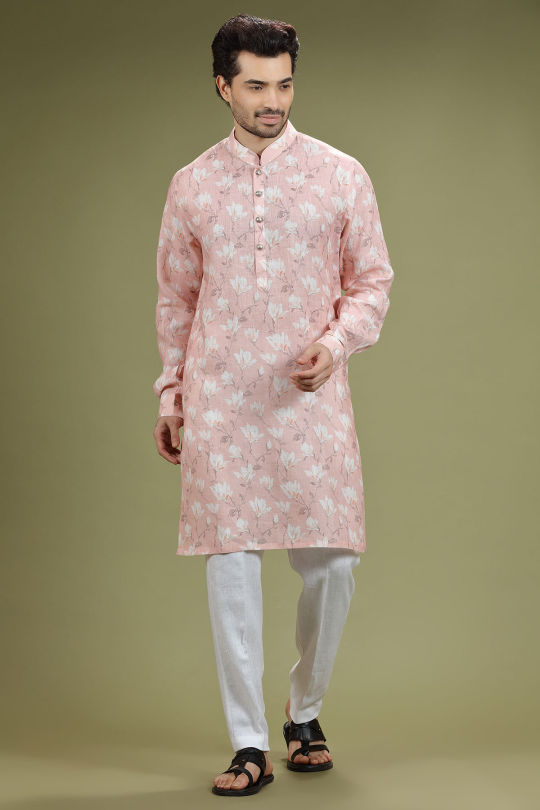
Makar Sankranti marks the end of the winter solstice and the beginning of longer days. As the sun starts its northward journey, symbolizing the arrival of warmer days, the festival signifies the triumph of light over darkness. The word “Makar” refers to the zodiac sign Capricorn, and ���Sankranti” signifies the sun’s transition.
Cultural and Harvest Celebrations:
The festival is also closely linked to agrarian traditions, marking the onset of the harvest season. Farmers express gratitude for the bountiful crops and pray for a prosperous agricultural year ahead. The festival fosters a sense of community as people come together to celebrate the abundance of nature.
History of Makar Sankranti:
Ancient Roots:
Makar Sankranti has ancient roots and finds mention in various Hindu scriptures. It is believed that the celebration has been observed for thousands of years, dating back to the Vedic period. The festival is not only a time for religious observances but also a way to celebrate the cyclical nature of the sun and its impact on agriculture.
Religious Significance:
In Hindu mythology, the day of Makar Sankranti is associated with significant events. It is believed that on this day, Lord Surya (the Sun God) visits the house of his son Shani (Saturn), signifying the end of their differences. Devotees take holy dips in rivers and visit temples to offer prayers, seeking blessings for prosperity and well-being.
Special Food During Makar Sankranti:
Sesame and Jaggery Delicacies:
One of the hallmark features of Makar Sankranti is the consumption of sesame and jaggery-based sweets. Til ladoos (sesame seed sweet balls) and gur (jaggery) are often used to prepare various traditional delicacies like til chikki, gajak, and rewri. These foods are not only delicious but also hold nutritional significance, providing warmth during the winter season.
Pongal in South India:
In South India, particularly in Tamil Nadu, the festival is celebrated as Pongal. The signature dish, also called Pongal, is a special rice dish cooked with newly harvested rice, lentils, and jaggery. The act of boiling over of milk during the cooking process is considered auspicious and symbolizes abundance.
Kite Flying Tradition:
Symbolism and Tradition:
One of the most cherished traditions during Makar Sankranti is kite flying. The sky becomes a canvas for colorful kites, creating a breathtaking spectacle. The tradition of flying kites symbolizes breaking free from the past and soaring high with new aspirations. It is believed that the higher the kite flies, the closer it gets to the divine.
Kite Festivals:
Across India, various states organize kite festivals during Makar Sankranti, attracting participants from all walks of life. Cities like Ahmedabad in Gujarat are particularly renowned for their International Kite Festival, where the sky is adorned with kites of all shapes, sizes, and colors. These festivals promote community spirit and friendly competition among participants.
The Allure of Tradition:
Beyond the religious and cultural significance, this festival also provides a unique opportunity to showcase and celebrate India’s diverse fashion heritage. In recent times, the fusion of tradition and modernity has given rise to a trend that blends not only the classic charm of Sarees and Lehengas but also the ethnic allure of designer salwar suits and men’s designer kurtas, creating a fashion statement that resonates with the spirit of Makar Sankranti.
Saree Swagger:
Modern Drapes:
The saree, a timeless piece of clothing, has undergone a remarkable transformation in recent times. Traditionally associated with grace and elegance, the saree has now become a symbol of empowerment and style. The trend of ‘Sari Swagger’ encapsulates the fusion of tradition and modernity, as young individuals experiment with drapes, fabrics, and accessories to redefine the saree’s narrative.
Contemporary Draping Styles:
Traditional designer saree drapes like the Nivi style or the Bengali drape are being reinvented with modern twists. Experimental pleats, quirky twists, and unconventional pallu placements have become a common sight, allowing wearers to express their creativity and individuality.
Fabric Innovation:
The traditional silk sarees are making way for lightweight fabrics like georgette, chiffon, and organza. These fabrics not only enhance comfort but also provide a fresh and breezy look. Handloom sarees from different states are gaining popularity, promoting the rich craftsmanship of Indian weavers.

‘Sari Swagger’ is all about blending cultural influences. The fusion of designer fancy sarees with contemporary designer silk blouses, jackets, or even belts is becoming increasingly common. This blend of traditional and modern elements reflects a dynamic and evolving cultural identity.
Statement Blouses:
The blouse, once a modest accompaniment to the saree, has now become a canvas for artistic expression. Elaborate embroidery, intricate patterns, and bold designs transform the blouse into a statement piece that complements the elegance of the saree.
Contemporary Jewellery:
Traditional jewellery is being reimagined with a modern twist. Kundan, Polki, and temple jewellery are now paired with contemporary designs to create a fusion that effortlessly combines the old and the new.
Footwear Trends:
The choice of footwear plays a crucial role in completing the ‘Sari Swagger’ look. While traditional juttis and mojaris are timeless, contemporary styles like embellished sandals and block heels are gaining popularity, adding a modern edge to the overall appearance.
Lehenga Love:
Experimenting with Silhouettes:
Lehengas, traditionally associated with weddings and special occasions, are now finding a place in the wardrobes of fashion-conscious women for festive events like Sankranti. The ‘Lehenga Love’ trend focuses on experimenting with traditional silhouettes.
Asymmetrical Cuts:
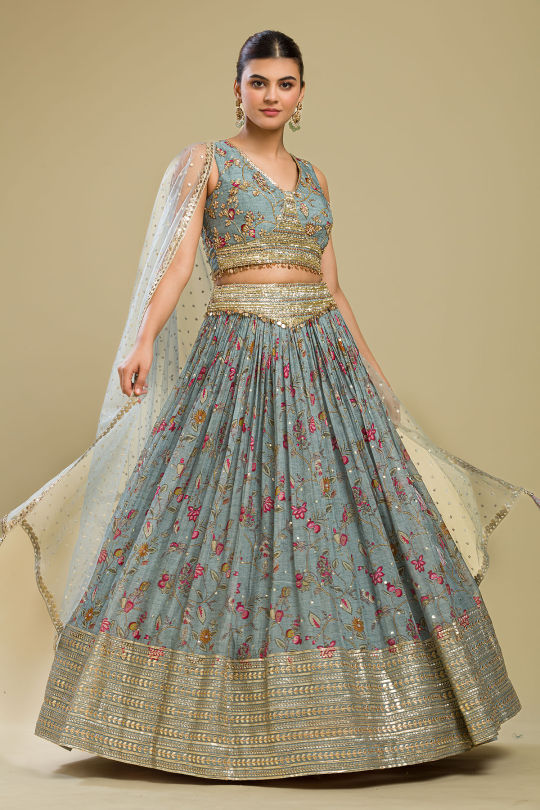
Designer Lehengas are no longer confined to the traditional A-line or flared silhouette. Contemporary designers are experimenting with asymmetrical cuts, mermaid styles, party wear designer lehenga and designer silk jacket lehengas. This experimentation adds a modern touch to the traditional ensemble.
Vibrant Colors and Embellishments:
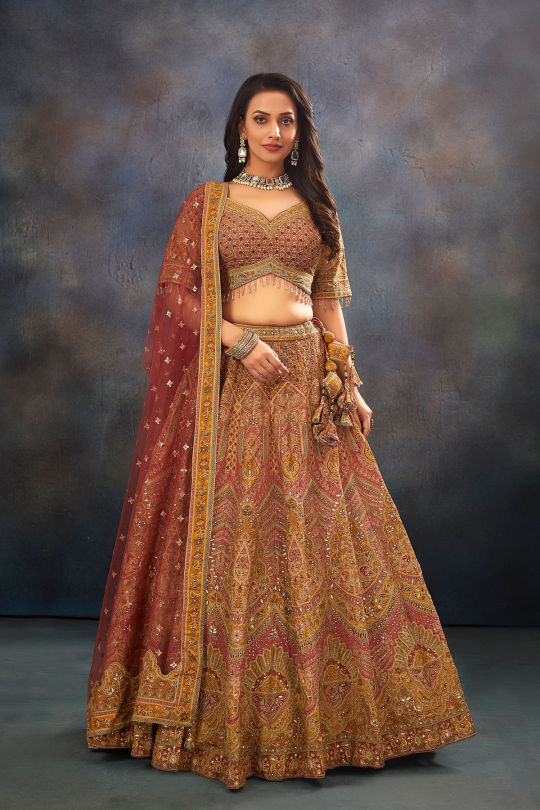
Makar Sankranti is a festival of colors, and this is reflected in the choice of lehenga colors. Vibrant hues such as mustard, turquoise, and emerald green dominate the designer festive lehenga palette. Intricate embellishments like mirror work, zari, and thread embroidery further elevate the festive vibe.
Salwar Suits for Women:
Comfort and Elegance:

Salwar suits continue to be a popular choice for women during Makar Sankranti festivities. Known for their comfort and elegance, these outfits provide a perfect blend of tradition and modernity. Lightweight fabrics and vibrant colors make designer salwar suits ideal for both religious rituals and festive gatherings.
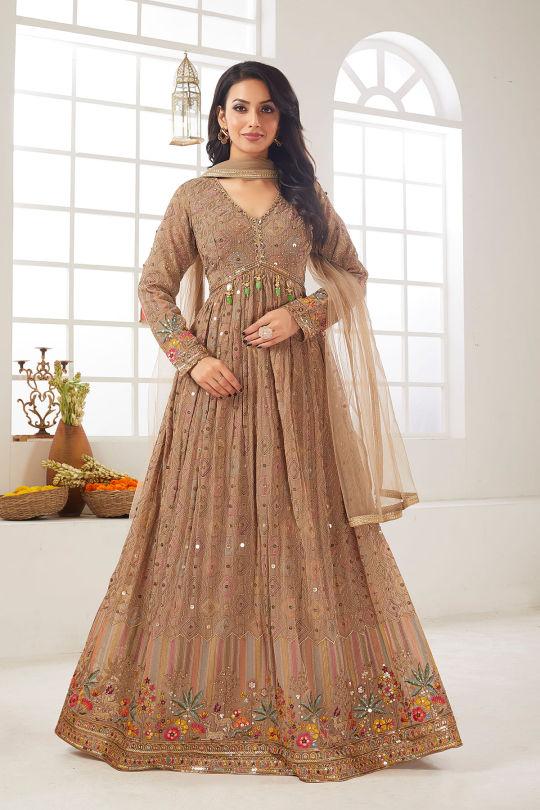
The versatility of festive salwar suits allows for a myriad of designs. From traditional Anarkali suits to contemporary straight-cut suits, designer sharara suit, designer palazzo suits, women can choose styles that suit their preferences. Embroidery, sequins, and mirror work add a festive touch, making salwar suits a go-to option for Makar Sankranti celebrations.
Fusion Styling:

Embracing the trend of fusion fashion, women often pair their ethnic salwar suits with modern accessories. Statement earrings, embellished juttis, or even a contrasting dupatta can elevate the overall look, making it a perfect choice for those who want to experiment with traditional attire.
Men’s Kurta:
Classic Elegance:
Men’s kurtas remain a classic and timeless choice for Makar Sankranti. The simplicity and elegance of a well-fitted kurta, often paired with churidars or straight pants, make it an ideal traditional ensemble. Solid colors or subtle prints are preferred, allowing men to participate in the festivities with sophistication.
Experimentation with Silhouettes:
The evolution of men’s fashion has brought about experimentation with designer kurta outfits. Asymmetrical cuts, shorter or longer lengths, and various neck patterns provide men with the opportunity to showcase their personal style while adhering to traditional aesthetics.
Incorporating Handloom Fabrics:
Handloom fabrics like khaki and silk are gaining popularity in men’s kurtas. These fabrics not only contribute to the rich cultural heritage but also add a touch of luxury to the ensemble. Handwoven details and subtle embellishments enhance the overall appeal, making the kurta a standout choice. Samyakk offers wide range of Kahki Woven Tuxedo suit, Light khaki zaro woven silk kurta, Resham Embroidered Silk Waistcoat kurta, Silk Modi jacket and Multi-color Printed Silk Kurta.
Cultural Impact:
Preserving Tradition:
The fusion of Designer Printed Sarees, Party Wear Lehengas, Plus Size salwar kameez, and men’s party wear silk kurtas during Makar Sankranti harmonizes tradition and modernity, defining vibrant festive fashion. It reflects a broader socio-cultural shift towards embracing and celebrating diversity. The amalgamation of traditional attire with modern elements not only preserves cultural heritage but also allows for a dynamic and inclusive representation of Indian identity.
Revival of Handloom and Indigenous Craft:
The revival of traditional designer outfits, handloom sarees, and ethnic embellishments in contemporary fashion promotes the preservation of cultural heritage. It encourages a sense of pride in one’s roots and contributes to the sustenance of indigenous craftsmanship.
Inclusivity in Fashion:
The acceptance of diverse styles and the breaking of gender norms in fashion demonstrate a growing awareness and acceptance of inclusivity. Fashion is becoming a platform to express individuality, irrespective of gender or cultural background.
Conclusion-
As Makar Sankranti approaches, the convergence of tradition and style takes center stage, epitomized by the fusion of Sarees and Lehengas. This auspicious festival becomes a vibrant canvas for self-expression, where individuals across India showcase a unique blend of cultural richness and contemporary dynamism through their fashion choices.
In this celebratory atmosphere,��Samyakk stands as a beacon of choice, offering an extensive collection that includes Kanchipuram sarees, Banarasi sarees, Designer sarees, organza sarees, and an array of lehengas – from Designer and party wear to Bridal lehengas. The brand’s commitment to providing enticing colors, diverse fabrics, and intricate embroideries aligns seamlessly with the festive spirit of Makar Sankranti.
As kites fill the skies, Samyakk invites individuals to soar to new heights of style and individuality, making Makar Sankranti not just a festival but a celebration of fashion, culture, and personal expression.
Wish you all readers a very prosperous makar sankranit from team samyakk.
Written by,
Shaloni Rao
#Saree#sarees#sarees online#online saree shopping#Pattu saree#sarees for wedding#indian wedding sarees#wedding designer sarees#kanjivaram saree#kanjivaram sarees#Kanchipuram saree#Kanchipuram silk saree#kanchipuram saree bridal#kanjivaram saree online#kanjivaram sarees online#kanchipuram silk#kanchipuram pattu sarees#kanchipuram silk sarees#kanjeevaram saree#Kanjeevaram Silk Sarees#bridal kanjivaram saree#kanchipuram saree bride#kanchipuram silk sarees for wedding with price#kanchipuram pattu sarees for wedding#kanchi pattu sarees#kanchipuram sarees#original banarasi saree#banarasi silk sarees#pure banarasi silk saree#Banarasi Silk sarees
0 notes
Text
A Journey inside the Mysterious Home of Goddess Kamakhya at the Kamakhya Temple
Located on Nilachal Hill in Guwahati, Assam, the Kamakhya Temple is a monument of the religious and cultural diversity of India. This ancient Hindu temple is dedicated to Goddess Kamakhya and attracts visitors and pilgrims with its fascinating history, stunning architecture, and tantric rituals.
One of the Mahavidyas, Goddess Kamakhya is the principal goddess worshiped in the temple. The sanctum sanctorum is a place of Tantric devotion because it contains the sacred image of the goddess yoni, who is revered for her fertility.
The reverence of the divine feminine essence is highly emphasized in Kamakhya Temple, which is famous for its ties to Tantric traditions. The spiritual atmosphere of the temple is enhanced when pilgrims participate in rites and ceremonies that originate from Tantric traditions.
A feature of the Kamakhya Temple calendar is the yearly Ambubachi Mela. The three-day monsoon closure of the temple represents the goddess's menstrual cycle. Attracting devotees from all around, the reopening on the fourth day signifies the conclusion of this time.
The stunning combination of Assamese and Bengali architecture is on full display in this temple. Various smaller temples honor different gods inside the complex's hemispherical dome, mandapa, and shikhara. Views of the Brahmaputra River and its environs are as spectacular as they are along the climb to the temple on Nilachal Hill.
Situated atop Nilachal Hill, Kamakhya Temple offers a calm setting with panoramic views in addition to being a significant pilgrimage destination. The spiritual significance of the ascent up a flight of steps is amplified by the verdant scenery that surrounds you.
Travel Spot: Throughout the year, devotees go to the Kamakhya Temple to pray to Goddess Kamakhya for her blessings. For Hindus of the Shakti sect and those curious in India's religious variety, the temple is a must-visit pilgrimage site.
The mythology and traditions surrounding the temple's foundation include passages from the Puranas. One such story includes Goddess Sati's sati and the subsequent scattering of her bodily parts, which result in the formation of Shakti Peethas. The tales surrounding the temple add to its charm and cultural importance.
Spiritual seekers and cultural aficionados alike find the mystical ambiance, cultural richness, and religious zeal of Kamakhya Temple to be an iconic destination, enticing them to explore the deep-rooted traditions of India.
0 notes
Text
Dr Birendra Nath Datta Passes Away
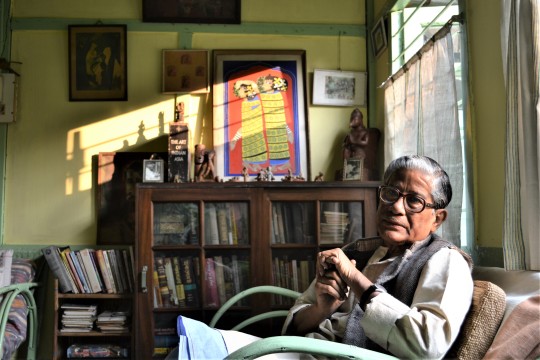
Photo Utpal Datta, from Rainsoft Celander
Dr. Birendra Nath Datta, a venerable luminary in the realms of education and folklore, has passed away, leaving a profound void in the hearts of many. At the age of 90, the distinguished scholar and musician took his last breath on a somber Monday morning. Dr. Datta succumbed to his long-standing ailments at 7 a.m. within the confines of Dispur Polyclinic Hospital, where he had been under medical care since October 19. This untimely departure has cast a pall of sorrow over the educational and cultural communities of Assam.
Renowned for his exceptional talents as a singer and composer, Dr. Birendra Nath Datta was a stalwart in the world of modern songs and Borgeet. His musical prowess extended to lending his voice to several Assamese films, and he also provided invaluable assistance to Music Director Salil Chaudhury during the making of the Assamese film, "Aporajeya."
Following his demise, Dr. Datta's mortal remains were brought to his residence in Silpukhuri, drawing family, friends, and well-wishers who converged to pay their respects. The final rites were solemnized at the Navagraha cemetery. Dr. Birendra Nath Datta is survived by his son, Dr. Uddalak Datta, a business owner in Delhi, and two daughters, Dr. Sudeshna Choudhury and Dr. Upasana Datta.
Born in 1933, Dr. Birendra Nath Datta achieved his Ph.D. from Gauhati University in 1974. His doctoral thesis, titled 'A Study of the Folk Culture of the Goalpara District of Assam,' exemplified his unwavering commitment to preserving and propagating the rich cultural heritage of Assam. Dr. Datta's distinguished career was adorned with prestigious accolades, including the Padma Shri Award in 2009, the Mahapurush Shri Shri Madhavadeva Award in 2006, the Ajan Pir Award in 2008, the Leo Advertising Silpi Sanman in 2010, the Manik Chandra Chowdhury Memorial Award in 2011, and the Tagore Ratna Award of Sangeet Natak Akademi in 2011.
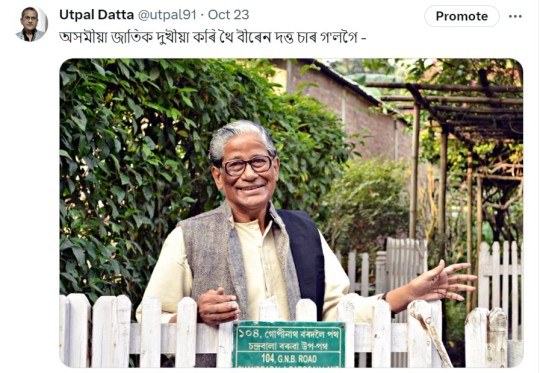
Tweet by Utpal Datta
Beyond his academic triumphs, Dr. Datta also held the esteemed position of President of the Asam Sahitya Sabha, a prominent literary institution in Assam, from 2003 to 2005. His influence extended to the realms of design and publishing, where a calendar featuring his photographs, released by the prominent publishing-design house RAINSOFT in 2010, created ripples in the cultural sphere of Assam. Dr. Birendra Nath Datta's legacy as a scholar, musician, and cultural icon will continue to resonate through the annals of Assamese history.
#AssamCultureIcon#FolkloreHeritage#MusicMaestro#AssameseScholar#PadmaShriAwardee#CulturalPreservation#MusicalLegacy#LiteraryLeadership#RAINSOFTCalendar#SangeetNatakAkademiHonoree#BirendraNathDattaLegacy#Utpal_Datta
1 note
·
View note
Text
Mark Your Calendar: CUET UG 2024 Exam Date Released
Common University Entrance Test-Undergraduate (CUET UG) 2024 will be held between May 15 and May 31, 2024. Check Registration Date, Application Form, Paper Pattern, Participating Central Universities.

CUET UG 2024 Exam: The Common University Entrance Test (CUET (UG) – 2023) will be conducted in 13 mediums across India for admission into the Undergraduate Programmes in Computer Based Test (CBT) mode for all the Central Universities (CUs) and participating Universities in India for the academic year 2024-25. The CUET UG examination is held for students who want admission into undergraduate programmes. Meanwhile, the NTA CUET PG examination is conducted for candidates who want admission into postgraduate programmes. National Testing Agency has been entrusted with the responsibility of conducting the Common University Entrance Test.
he National Testing Agency (NTA) has already released the examination dates for CUET Undergraduate (UG) and Postgraduate (PG) programs. Common University Entrance Test-Undergraduate (CUET UG) 2024 will be held between May 15 and May 31, 2024. Meanwhile, CUET PG will be held between March 11 to March 28, 2024.
CUET UG Exam Date 2024: When Will NTA Release CUET UG Registration Date And Time? The application form for CUET 2024 is likely to be released in February 2024. However, the date mentioned here is tentative in nature. So, to find the most up-to-date information regarding CUET undergraduate registration dates, we recommend visiting the official CUET website
CUET UG Exam Date 2024: NTA CUET UG Application Form Official Website Submission of the CUET Application Form could be made by the candidate online through the NTA website: https://cuet.samarth.ac.in/. Along with the CUET application form, NTA will publish the CUET UG 2024 information bulletin. Before starting to fill the application form candidates are advised to read the Prospectus displayed on the website of the University/ies where admission is sought and be clear about the courses offered by them, seats available, eligibility as regards age, passing/appearing in qualifying exam, minimum marks in the qualifying exam, relaxation thereof, reservation, admission procedure, etc before applying for the CUET (UG) – 2023, as Universities have their own specific requirements for admission to specified courses. NTA will not entertain the corrections sent by the candidate through Post/Fax/WhatsApp/E-mail/by Hand. CUET Exam Date 2024: NTA CUET UG Pattern, Mode, Medium, Syllabus
CUET Mode of the Test: Computer Based Test-CBT CUET Test Pattern: Objective type with Multiple Choice Questions Medium: 13 languages (Assamese, Bengali, English, Gujarati, Hindi, Kannada, Malayalam, Marathi, Punjabi, Odia, Tamil, Telugu, and Urdu ) CUET Syllabus Language: Language to be tested through Reading Comprehension (based on different types of passages–Factual, Literary and Narrative), Literary Aptitude and Vocabulary CUET Syllabus Language: Domain Subject: As per Class 12 syllabus only. CUET Syllabus Language: General Test: General Knowledge, Current Affairs, General Mental Ability, Numerical Ability, Quantitative Reasoning (Simple application of basic mathematical concepts arithmetic/algebra geometry/mensuration/statistics), Logical and Analytical Reasoning CUET Registration: Registration will be online at https://cuet.samarth.ac.in/ CUET UG Participating Central Universities A single Examination will enable the Candidates to cover a wide outreach and be part of the admissions process to various Central Universities. As per the CUET UG 2023 Information bulletin, here is a list of central universities.
Aligarh Muslim University Assam University Babasaheb Bhimrao Ambedkar University Banaras Hindu University Central University of Andhra Pradesh Central University of South Bihar Central University of Gujarat Central University of Haryana Central University of Himachal Pradesh Central University of Jammu Central University of Jharkhand Central University of Karnataka Central University of Kashmir Central University of Kerala Central University of Odisha Central University of Punjab Central University of Rajasthan Central University of Tamil Nadu Dr. Harisingh Gaur Vishwa Vidyalaya Guru Ghasidas Vishwavidyalaya Hemvati Nandan Bahuguna Garhwal University Indira Gandhi National Tribal University Jamia Millia Islamia Jawaharlal Nehru University Mahatma Gandhi Antarrashtriya Hindi Vishwavidyalaya Manipur University Maulana Azad National Urdu University Mizoram University Nagaland University North Eastern Hill University CUET UG Paper Pattern Objective type Multiple Choice Questions (MCQs).
CUET UG Exam Date 2024: How to Fill NTA CUET UG Registration Form? Step 1: Registration Form: Register for the Online Application Form and note down the system-generated Application Number. The candidate should supply the required details while filling the Online Application Form and is also required to create a PASSWORD and choose Security Question and enter his/her Answer. Step 2: Application Form: The Candidates can log in with the system-generated Application Number and pre-created Password for completing the Application Form including filling up personal details, providing the details of educational qualification, university/programme selection, test paper details, choosing the ExaminationCities, and uploading the images and documents (if any). Upload Scanned Images of Candidate’s Photograph, Signature, and Category Certificate (if applicable), and PwBD Certificate (wherever applicable): Step 3 Fee Payment: After completing Step 1 and Step 2, the candidates have to pay the requisite examination fee. The fee can be submitted only online through Net Banking, Credit Card, Debit Card or UPI. Processing charges and GST as applicable are chargeable to the candidate (in addition to the examination fee) by the concerned Bank/Payment Gateway Integrator. Download, save, and print a copy of the Confirmation Page of the Application Form.
0 notes
Text
বসন্ত আৰু বহাগ।
‘বসন্ত’ is an assamese word for spring, the season and ‘বহাগ’ is the first month of the year in Assamese calendar which falls in mid-april.

Illustration of bohag
This illustration is a recollection of the memories I had of me celebrating bihu with my family since childhood. And an attempt to represent bohag and boxonto in Assam. The yellow pair of flower popularly known as ‘togor phool’…
View On WordPress
1 note
·
View note
Text
The Minority Rights Monopoly of a Hindutva Nation
The game From seventy years, it has been the favorite game of Hindutva. The greatest monopoly in this world - that is called minority rights.
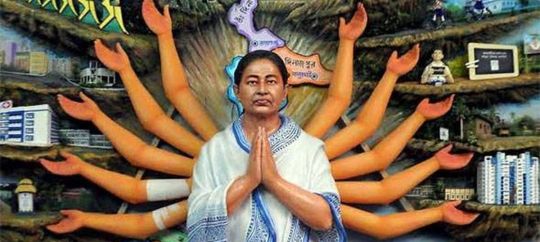
There is a traffic stop here. The signal is red. Unless you are a minority, you will never know how does it feel. You can not put yourself in the shoes of a minority, if you are a majority. For me, being a minority is an everyday thing. I struggle with my religious identity all the time. I face questions, I reply them, and I get into arguments. In this world of Islamophobia, my faith is put on trial every day. I know perfectly well that nobody wants to become a minority. If I were a Hindu, I would be grateful for it. I wish I were a Hindu! I wish I were a Christian! A Buddhist, a Taoist - anything at all but a Muslim! If I were something else, I would be free. I wouldn't have this ordeal. I wouldn't have to go through things I now fight with for being a Muslim. And I know the ways around that word, minority. There are too many ways to use this word, to abuse it and exploit it. It is a legit word. In all context and circumstances, a minority is a minority. It means that there is a group of people who do not posses the same privileges as their majority counterpart. And the world is always against them. In our subcontinent that exists down the Himalayas, we have been majorities and minorities from hundreds of years. From the last seventy years, it has become a game. Instead of cards, dice, deeds, game cash and tokens, we have people here. Real people. Mostly, we play it through riots.

We don't purchase properties. We plunder them. We confiscate properties left behind by our enemies. During riots, we forcibly take them away. We take over controls. We take things that did not belong to us, had it not been for a religious bloodshed.
This is the reality of Indian subcontinent. The game is our destiny. All of us, Hindus and Muslims. Our ancestors played it. They rolled the dice. They kept playing, until the last day of their existence. They've left the court afterwards. It was for us to take over. And now we're playing it. This is our history. Made of countless tales of religious wars, creating and separating countries. That is how India, Pakistan and Bangladesh were created, each with their own religious agenda. Far from it all, I live here in Malaysia, a country where nobody is playing games with religion. Here, people spend away their whole lifespan peacefully. Without trouble. Malay Muslims, the local Tamil Indians and the Malay Chinese. The last time a riot broke out was in 1969. In the Indian subcontinent, it is a completely different story. Rolling the dice Bangladesh is the youngest of nations down the Himalayas. This is where I am from. The official agenda of creating this country was secularism, which turned into pro-India servitude soon enough. While India is your neighbor, trust me, you can not afford to be a secular. If secularism means watching mosques destroyed and keeping your 'Muslim' mouth shut, then you can. You can simply shut up. That's absolutely fine, with both slaves and masters. The relationship between Hindus and Muslims in this territory has always been that of either slaves or masters. Masters were rich, slaves were poor. This is the reason behind the creation of Pakistan, to free Muslims from Hindutva's slavery. That is how the poor, low class Muslims became a Middle class. Bangladesh broke away from it in early 70s. It was East Pakistan. The only Pakistan that remains now was the West Wing of it. Since the beginning, India was rolling the dice. To roll the dice is to create an issue. Mostly, a religious disturbance. India has always been the mightiest in population, in economy and in every other aspects. So, the other countries nearby were expected to pay tax to it. To their master, India. The history is long, and endless. Babri Mosque, in 1992, shaped much of what it is now.
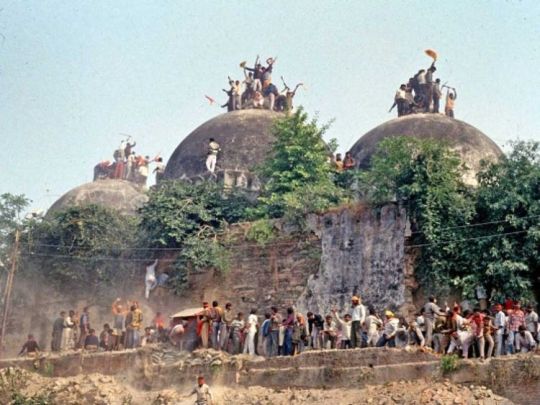
People witnessed multiple narratives from both sides. Muslims had their mosque destroyed, crushed to the ground, while Hindus were reading a book called 'Lajja', authored by a woman called Taslima Nasreen. Muslims called the book a 'BJP propaganda'.
It was the biggest demolition of something so big of its kind, in the recent history, before 9/11. When Twin Towers were destroyed, 9/11 replaced the Babri day in calendar in the magnitude of events. Back then, Hindutva rolled the dice. It created the saga. Riots broke out everywhere. In Pakistan, India and Bangladesh. In 2019, Hindutva rolled the dice once again. Again a woman, this time. Because in the age of colonialism, which likes to camouflage itself as liberty, female is the right gender. Things become soft core when it is a woman. Besides, New York Times can always decorate its headlines with words like 'Meet the Woman.'
So we had a Priya Saha. She went straight to Donald Trump. Could it have been a Muslim woman, in the stead of her place? Who would it be? Malala Yousufzai? She's a Nobel laureate, and she's a Muslim. She could have gone to Donald Trump and expressed her distress. But it would risk her image. Already she is mocked at in her own country, Pakistan. Then who? A Gujarat riot victim? Somebody from Assam? The Indian state where they were hunting down the Muslim poets right before it happened? There were some poets among them who were women. They did not get a US visa. Priya Saha got it. I still remember the day before it happened. People in Facebook were posting about this 'Miya poetry', which were elegies of the Assamese Muslim minority. They were written in the local dialect. A dialect that is not considered entirely 'polite' or 'standard', when it comes to the traditional literature.
The next day, Priya Saha's video went viral. It was a short clip. Roughly, a few seconds. It contained a footage of 'the Hindu Lady and Donald Trump', almost a Disney story of an unknown woman holding hands of a US President.

For what I know, I've never heard of Priya Saha before. I did not know who she was. The first time I learnt about her was 18 July 2019, after her video popped up in Facebook. When the clip was out, everybody in Bangladesh forgot about everything else. For the next thirty days, Facebook was all about Priya Saha. She alleged, 37 million Hindus are 'missing' from Bangladesh. That is a genocide. Probably the largest in the world. We have our war jokes there, about 3 million people who had supposedly perished in the war against Pakistan. Now the Bangladeshi people, the Muslims - were looking for these 'missing' 37 millions. In Bangladesh, it became a new joke. Because we always count in 'millions'. She said, Bangladesh still has 18 million Hindus. Some of them were out proving her number. Among the 37 millions, probably 30 million Hindus were never born, who could have been born otherwise, had Muslims been kind to them. In the Muslim majority nation, it took the joke even further. Not being born started to seem like a thing that's funnier. If we count from 1947, that is a true number - although. That was the year of India and Pakistan's creation. Had the demographics flowed on the way it did before, we might have had 30 million unborn Hindus who would grow into adults by now, plus 7 millions more who were displaced and exiled.
Priya Saha referenced a professor, who has a Muslim name, Abul Barkat. He disowned her statement.

Once again, Muslims were the violent majority. Their reaction was something Westerns would call 'outrageous'.
Thanks to BJP, that it exists. There are, somehow, balance in things. The Bangladeshi Muslims know about their existence. We did not want to deliver BJP their next propaganda, after Nasreen's 'Lajja'. That is how the riot did not happen. We were expecting a riot. We were scared of it. But the fear of a BJP propaganda making gains and profits was much more greater than that - to the Muslim majority. That fear, stopped the riots. Not a single Hindu died. Not a single Hindu was killed. There were no mass rapes of Hindus. No Hindu girls were stripped nude in broad daylight. BJP wanted all of it to happen. They did not, unlike before. From time to time, such things did happen in Bangladesh. And they gave BJP a solid ground for their arguments. This time, there was no bloodshed. No massacre. At the end of the day, it made the Muslim majority feel more confident. This was the first time they ran down a Hindu woman for a complain like this. In the recent Awami regime, that too was unheard of.
Some of them felt more radicalized. The Hindus were silent. The Muslims accused them of 'having more privileges’ under the Awami regime. As they said, Hindus were getting more jobs, government was hiring them in more top posts and etc. Hindus did not reply to it. They did not want to make the noise louder. They wanted it to die down, as minorities do. In US, Priya Saha did not make news, simply. Nobody in Trump's country heard of her from the US media. The New York Times was busy with Ilhan Omar's minority politics. Not that it did not know about Saha, it decided to skip it. Regardless of the turmoil in the South Asian country that their President has caused.

BJP did not shy away from it, though. They protested against the Bangladeshi Muslims in front of the country's consulate in West Bengal. BJP did not deny that it rolled the dice, either. They admitted it quite frankly, that they sponsored Priya Saha.
They rolled the dice. The game started. The show was on.
Priya Saha went on saying, 'I've learnt all this from Sheikh Hasina, my Prime Minister. She inspired me to say this. Now I feel endangered. My life is threatened.'

The Game After Nothing can be right and wrong at the same time. Either it is right, or it is wrong. BJP kills Muslims for eating beef. Either it is right, or it is wrong.
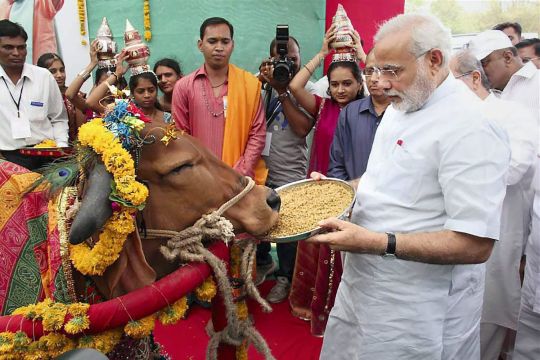
Muslims threatened Priya Saha and called out their desire to turn her into a whore. Either it is right, or it is wrong. 37 Millions might have been a fat fetched number. But some Hindus were displaced, raped and burnt. Either it is right or it is wrong. So, who is the guilty party here? Who's guilty? BJP, or Muslims? What if they both are criminals? The fact is, nothing is that simple. Nobody is guilty as a community, just as nobody is innocent as a community, either. At least in our part of the world, where these things happen. BJP rose to power after killing thousands of Muslims. If they killed millions, that would have been crazier. They openly threaten their Muslim minority in India with it. They say they will kill millions.
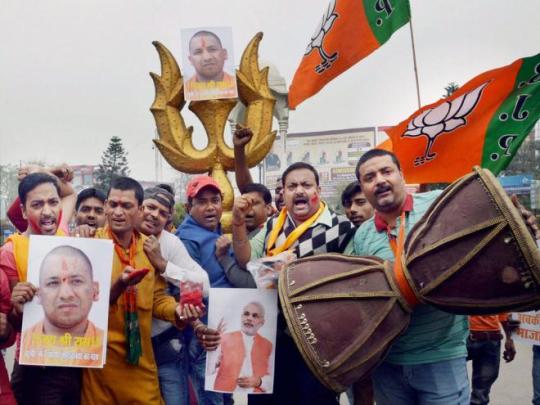
Either that is right, or that is severely wrong. It can't be both at the same time. There was no jury board here. Nobody awarded BJP a 'Freedom of Speech prize', or punished the Muslims - for the Priya Saha episode of Bangladeshi history. The same Awami regime who came to power through BJP's machinery were quick to declare their indifference. Although the PM said that Priya must be given a chance to defend herself. So, the issue was not solved. Priya Saha complained. What after that? Should Muslims change their behaviors towards Hindus? Should BJP change its behavior, towards every other minority around India? People did not have answers to these questions. Everybody knows neither India nor Bangladesh is Malaysia. Here, people use the word 'race' instead. They take courses about interracial relations. Muslims, Hindus and Buddhists live side by side, in the Malaysian society. Most of them don't practice secularism. They practice their own religion. The country's constitution keeps Islam as its state religion - that doesn't stop the Malaysian youngsters from pursuing diverse lifestyles that are completely westernized. Some Malaysian girls choose to wear Hijab, others pick Bikinis. In India, that is impossible. It is sort of impossible in Bangladesh as well, unless you are very rich. You at least have to be from the middle class, with your social securities guaranteed. For us who are from either Bangladesh, India or Pakistan, we don't see our countries going somewhere remotely near to that in the next hundred years. We are a war-torn populace. In Malaysia, we pretend like we don't mind each other. That we are absolutely fine with each other's nationality and presence. Here in Malaysia, Indian and Pakistanis are friends. Even couples. Back home, we are enemies. The deadliest enemies of each other. So, those of us who escaped but still are suffering from irrational homesickness, we look back to our countries. We check Facebook, Twitter and Instagram. We see what is happening. Thus, we live two different realities at the same time. The Malaysian reality and the reality of our homes. After a month, Priya Saha was still hot in newspapers. Here were the Muslims, still blasting her without mercy. However, there were no riots. Only the ISKCON was closing down. That's the only blow the Hindu community has taken.
BJP couldn't make much profit out of it. There wasn't enough materials to write a new novel. Probably, a sequel of 'Lajja.' So, Hindus were unharmed. For the first time perhaps. It is not natural. While Muslims did not harm them, they still kept bashing. Through their words. It was a great insult, for sure. Having no rise of terrorism in the country was an insult, too. BJP was literally insulted, with no terror whatsoever. No temples were exploded with bombs. In Bangladesh, people do tolerate each other. It is not communal harmony, it is tolerance. The very basic of it. Nobody is fanatic enough to drop a bomb in a temple. It is not middle east. But that is of no use to BJP. BJP wants more novels. More Taslima Nasreens. More Hindutva bestsellers. Frankly speaking, once upon a time, this woman's words were dangerous enough to set off a riot in the country. She still keeps setting riots, but in India. If a minority person complains about the sufferings of a minority, can you simply call it Hindutva? Can you silence it? Can you turn down the volume? The question is, should you? Even if it sets off riots? Priya Saha is from the Minority community. Her words were setting off riots. Almost. That is the fact. Had she did not went to Trump, Bangladesh wouldn't be in an almost riot situation. She chose Trump for it. People started questioning, since when did Trump become the jury?
The fact is, the riot was not provoked by Muslim hardliners this time. But here was BJP, deprived of its chocolate. Its unborn bestseller. Like a naughty boy in the street who can't have his ice cream, after the ice cream trolley has went away without stopping.
Now the naughty boy wanted to destroy the world. Because the whole world was criminal enough for having ice-creams. He was deprived of it. He missed. Soon enough, in the following month of August, it was the article 370 of Indian constitution that was tampered with, instead of born and unborn 37 millions. It cracked like a firework in whole Bangladesh, right after Priya Saha. Muslims and Hindus were at it again. That article, in that fucking constitution, gave Kashmir a statehood. Before BJP tampered it, the Indian Kashmir was still a state. The Pakistani Kashmir was Azaad, free.
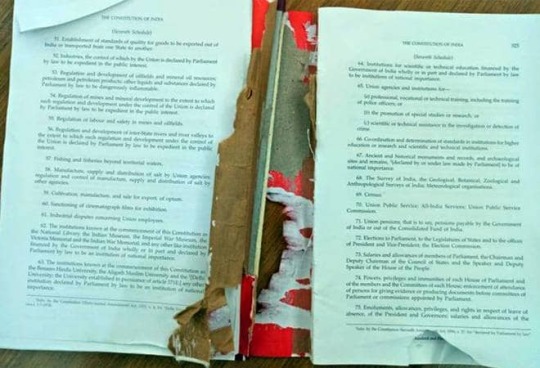
How easy it is to play with people's lives! Lives of millions! All it takes is a fucking constitution. A Muslim MP in India ripped it apart before walking out of the parliament that day.
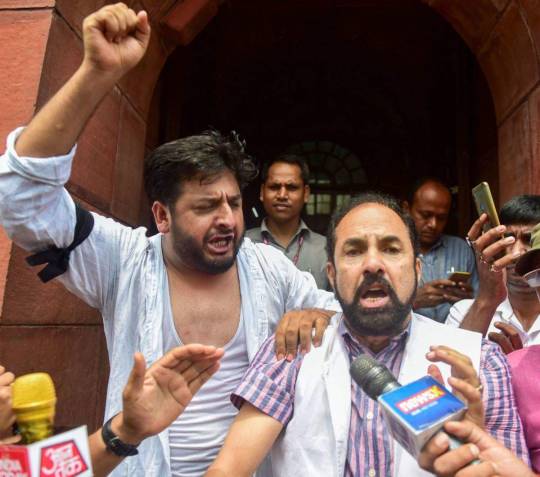
37 millions was a joke. 12.5 million people of Kashmir, of which 68% are Muslims, was not even a good tragedy. These millions of Kashmiri Muslims were already 'have been born'. Nobody offered a figure for how many million weren't born there. After BJP passed a bill that changed Article 370, the newly revised constitution was shoved down people's throats. They happened to be Muslims, from Kashmir. It was 5 August 2019, the day India dismissed the article. Exactly 18 days after they cracked Priya Saha.
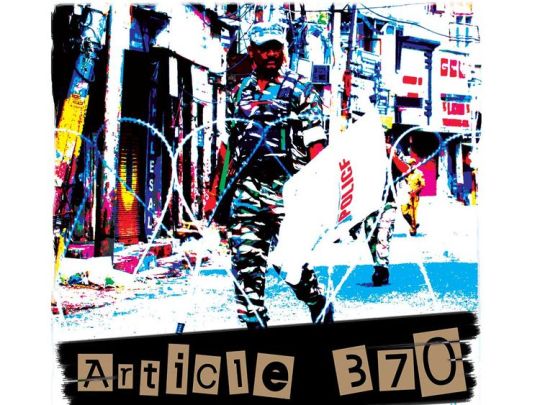
Right now, Kashmiri Muslims were fleeing for their lives. The Indian Kashmir was no more a state. Now Hindus could purchase lands there, an option they did not have before.
The state/territory was put under a lockdown.
Nobody could get in or out. The internet was cut off. The Kashmiri newspapers stopped. Phones were disconnected. All communications ceased.
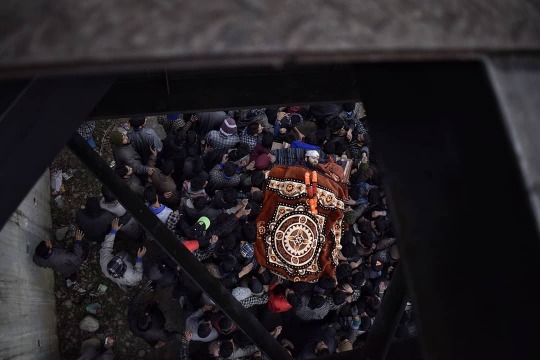
Twenty days later, as I'm writing this in the evening of 25th August, the Kashmiri newspapers are still not back online. One of my Kashmiri friend in Malaysia, did receive a phone call from his family in Kashmir the day before yesterday, for the first time after lockdown. Rest of it, nobody knows. In today's world, nobody knows what is happening in a state/territory that is placed under a lockdown. New York Times has been there. They came out with horrific pictures. But the world is too tired for horrors in Kashmir.

But a few videos were somehow uploaded online. They show people running to-and-fro, in the hospitals. Apparently too many has been injured in Kashmir. People are assuming they are Muslims, leaving a few Indian soldiers aside. Yeah, some Jawans of the Indian military also suffered major and minor injuries, when the locals threw rocks at them. Imran Khan, the Pakistani PM, compared it to 'Nazi ideology', this ghettoization of Kashmiri Muslims. He still refrains from sending his troops for a war, although. But BJP is calling for a war. War is what it wants. War is what Kashmiris want, too. Because Kashmiri Muslims want Azaadi, freedom. Kashmir has its own history. In 1947, the states and kingdoms of British India were asked to join either India or Pakistan. The Hindu Rajah of Kashmir, decided to join India. Without giving a damn to the Muslim majority in Kashmir. Eventually, Kashmir was divided into two. Azaad Kashmir, that is in Pakistan, and the Occupied Kashmir in India, as most Kashmiri Muslims from both sides and Pakistan calls it. The Maqbooza Kashmir, in Urdu.
The same BJP that kills Muslims for eating beef has unleashed its terror in the Maqbooza Kashmir.

It is still allowing the foreign press there. New York Times, BBC and all. But from the Kashmiri people, not a word has been heard from last twenty days. Trump is here again. After Priya Saha, he's now saying he will 'mediate' between Pakistan and India. His 'mediation’ will bring peace, he said. But the Kashmiris want Azaadi, which is impossible to achieve without breaking peace. Azaadi means either Maqbooza Kashmir joins Pakistan or it breaks away from India, like Bangladesh did - from West Pakistan. Either way, Azaadi will make India lose some geography completely, forever. A 'peace process' will return the Occupied Kashmir its lost statehood, at most. That's not what Kashmiris want. They've suffered enough when it was a state. They are suffering when it is no longer a state, too. They wanna break free. Absolutely free. Free from India.
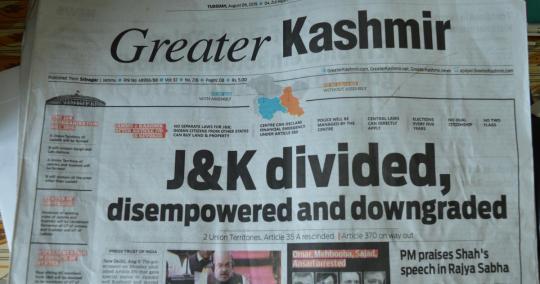
That is not Priya Saha's concern, for sure. But when the lockdown started, BJP asked Hindus to 'go marry the Kashmiri girls (and convert them to Hinduism)'.

There aren't 37 million Muslims there. There are millions of them, though. 68% of the 12.5 million, how much is that? Almost 8.5 million. A lot of these 8.5 million Muslims are now in police custody. Being a Muslim is a crime under the laws and codes preferred by BJP. Many of them are in hospitals, injured. As reports are coming, those hospitals are being raided by Indian military. Kashmiri women have been raped since history. From years. There is a mass rape epidemic in Kashmir. The raped girls are all Muslims, all the rapists are Hindus. There has been countless mass killings. Each with a different name. Kunan Poshpora, Sopore, Kupwara, Varmul.

BJP has a plan for it all. It asked Hindus to purchase lands there so that it can replace the Kashmiri Muslim majority with a new Hindu majority, within a few upcoming generations. The majority Muslims will lose their majority status, eventually. In the demography. It looks like the 'missing' 37 million of Priya Saha have flocked there in Kashmir, straight from Bangladesh. They will avenge Bangladesh with Kashmir, turning the majority Muslims into a minority. After Priya Saha, not a single Hindu girl was raped in Bangladesh. They have been raped before. During the war with Pakistan, they were raped and killed. After the war, they were raped during the riots. This time, there wasn't. Not a single one. The Kashmiri girls are being raped. Right now. The Kashmiri boys are being killed. After Priya Saha. Right at this moment. The Monopoly
What makes a minority? Is it just numbers? Numbers are stupid, come on!

Minorities come in all shapes and colors and sizes. They are tall and short, fair and white as well as pitch-black skins. In Africa, certain human species were wiped out because they were dwarfs. They did not have the normal height as other people. Now they are wiping out Muslims. The definition is not just numbers. It may vary here and there, but all the minorities in the world have a common feature. They are discriminated against, and they suffer bigotry. If I am not hired for a top post in a company because of my religion, it makes me a minority - despite the demographics telling otherwise. If a company hires a Hindu man to appoint him as their CEO just because he is a Hindu, it makes him a majority. Because he is sharing the same privileges with the majority religion and gaining unfair advantages for his religion. If a country's police department never arrests criminals from Hindu religion just because he's a Hindu - it does make them the ruling majority. Because a Muslim criminal wasn't to be spared for the same crime. Only the majority knows how to get away with religion. Minority does not have that chance. So, demographics often lie. The majority-minority binary doesn't stop at religion, either. It goes as far as people's sexuality, their lifestyles and professions as well. Bangladesh have a Hindu minority. So did Kashmir. Kashmir's Hindu Pandit minority had to evacuate the valley, when tensions ran high.
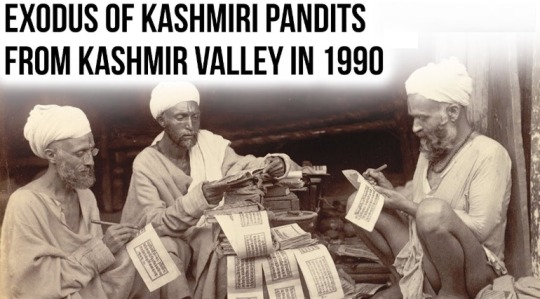
Kashmir's Muslim majority is now being butchered by Indian Hindus - who are not from Kashmir. These butchers are no Pandits, either. In no definition of the world, the butchered people are a ruling class. The ruling class are never persecuted. The ruling class are not shot dead. That never happened in the human history. Both the Kashmiri Muslims and the Kashmiri Pandits are minorities - in their own ways. Next the demography will change. Kashmiri Muslims will become a minority in numbers as well. If they are still the majority, they are asking for their majority rights perhaps. That is the kind of stuff happening in Kashmir. The situation in Bangladesh is not that different. Except that we saw Hindu houses getting burnt as recent as three years ago. People burnt their houses and started looting them. I don't remember Muslims hailing the looters, but they say those were political goons. But that made me realize that yes, it still can happen. Three years ago, BJP had its chocolate, too. It did not stop in Bangladesh. The Indian Hindu fanatics celebrated that riot in Nasirnagar. It gave them exactly what they wanted, excuses to kill Muslims.

The Bangladeshi cops setting fire on a Santal tribal village
It stirred up emotions to get BJP exactly what it wanted as well, more Hindu votes. Priya Saha alleged that her house was burnt down. Not in Nasirnagar, it was somewhere else. Bangladeshi media said, she's torched her own house herself. Never mind Bangladeshi media, they suck. However, a thousand homes were burnt down in India because they belonged to Muslims. The Muslim shops, looted. Cash boxes, vandalized. There were Bilkis Bano, Jakia Jafri. There was Israt Jahan, a Muslim girl killed in a false encounter.

Did Bilkis Bano ever fantasize to reach Donald Trump? Did Jakia Jafri want Donald Trump to listen to her story? Did Israt? Would the White House let them enter? It is the same thing. They too are minority. That day, Donald Trump was there to listen to all the stories from minority people around the world, in his oval office.

There were some Rohingya Muslims, too. But Jakia Jafri wasn't there. Bilkis Bano wasn't there. Israt was dead long time ago. No Kashmiri was there, either. Besides, Donald Trump shares a very good friendship with Narendra Modi. Why was the Indian minority 'missing' in his oval office that day? Some people asked, some didn't. Because everybody knows it is the same thing, but it is not the same thing. Being a minority is not the same thing for Priya Saha and Bilkis Bano. The later is a Muslim, the former, Hindu. It is not the same thing, in our subcontinent. Priya Saha can meet Donald Trump if she wants. The Muslim minorities can not. Israel and US will listen to her if they feel like it. They rarely listen to Muslims. Donald Trump declared a 'Muslim ban', a few years ago - if I need to remind you. Trump is 'mediating'. That is not stopping Hindus. That is not stopping Narenda Modi from butchering Kashmiris. So, what's the conclusion? Both the Hindu minority and Muslim minority are in hellfire. The majorities are roasting them both. But when it is the Hindu minority, their stories make best sellers. When it is Muslims, France Germany Italy Nicaragua Israel and a few dozen of other countries are not interested. So a man asked in Facebook, a Muslim man from Bangladesh. He said, 'thousands of Kashmiri girls are killed and raped everyday. They aren't winning a Nobel prize for it. Malala did.'
Kashmiri girls are not Malala. They are not fighting the 'war on terror'. So, when they will pen their stories, it won't sell. Mostly, the Bangladeshis, Pakistanis and Indians will read it.
The Hindu minorities get that extra favor. Muslim minorities don’t. Hindutva always excuses its crimes with their Hindu minority. Muslims make no excuses, officially.
Is this really about minority, at all? Or is it about Hinduism? The Hindutva brigade expanding its territory?
To this day, Indians are the sole owner of this monopoly. Because they placed their minorities in Muslim lands. They alone play this minority rights monopoly. They even make money with it. They make a thriving business out of their sufferings. The Indian subcontinent's Muslims did not join them. Their Bilkis Banos were not sexy enough for Donald Trump. We have a minority, too. We have only God to complain. When the God finally listens.
Asif Tamoso 25 August 2019
(Photographs: Collected)
youtube
#Muslim#Hindu#Minority#Majority#India#Pakistan#Bangladesh#Kashmir#Priya Saha#Donald Trump#Sheikh Hasina#Taslima Nasreen#Ilhan Omar#Article 370#Indian Military#Police#Indian Army#Azaadi
3 notes
·
View notes
Text
Why do we celebrate Makar Sankranti?
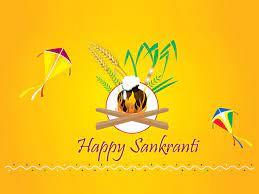
2023 MAKARA SANKRANTHI FESTIVAL
The Hindu festival of Makara Sankranti is one of the most auspicious festivals, dedicated to Surya (sun). As the sun passes through one zodiac sign to another, Sankranti is celebrated. "Makar Sankranti" is the first Indian festival that occurs in January.
Sankranti is celebrated every year on the 15th of January. There are many cultural forms and different names associated with this Hindu festival that is celebrated almost everywhere in the country. It always falls on the same date each year (January 14) according to the Gregorian calendar since it celebrates the solar cycle. The festival associated with Makar Sankranti is known by various names, including Maghi by north Indian Hindus and Sikhs, Makar Sankranti in Maharashtra, Goa, Andhra Pradesh, West Bengal, Karnataka and Telangana, Sukarat in central India, Magh Bihu by Assamese, and Thai Pongal by Tamils. book a pandit
Colorful decorations, agriculture, singing, kite flying, bonfires, and feasts are part of the Makara Sankranti celebration. Many people bathe in holy rivers or lakes in remembrance of the sun. On Makara sankranti, a lot of people go to temples. It's estimated that 40-100 million people go to temples. At the Kumbh Mela, they pray to the sun and take a bath at the Prayaga confluence of the Ganga and Yamuna, a custom said to have been started by Adi Shankaracharya.
MAKAR SANKRANTI:
What is Makar Sankranti: Agriculture has been a deep-rooted part of the Indian public. The festival of Makar Sankranti is celebrated across the country in separate ways, with people welcoming the new season of harvest in their own cultural way. On this day, many pray to Goddess Saraswati for knowledge and wisdom. This festival highlights the importance of pulling back from unethical and unhealthy behaviors while practicing for peaceful and positive ones instead.online pooja
SIGNIFICANCE OF THE FESTIVAL-
"Makar," Capricorn, and "Sankranti," both mean "change." This festival, also known as Makar in Sanskrit, commemorates the Sun's transition into Capricorn. Saturn is the planet that rules Capricorn, according to astrology. Additionally, this planet is thought to be the son of Lord Sun, Surya Dev. Simply put, this indicates that the Sun visits His Son during this time. This time of year also represents letting go of disagreements and resentments, allowing one to embrace the world's beauty and love! Establish more meaningful relationships with the people you love with the help of the Sun's positive energy; let us put aside silly arguments and focus on the good times.pandits online
This festival stands out from other Hindu festivals in particular because Makar Sankranti is celebrated on a dedicated date—on January 14 each year. The Sun begins to move in the opposite direction, toward the north, at the same time. The celebration likewise recognizes the point from which the cool, short, stormy days give way to longer and hotter months. Because there isn't enough sunlight during the winter, crops don't get a good harvest. Because of this, the Sun moves to the north, which makes everyone happy about the possibility of a better harvest!
CELEBRATIONS RITUALS:
The festival is celebrated in many different ways throughout the country.
According to localities, cultures, and traditions, each region celebrates differently, performs rituals, and practices customs.
The grand festival of Holi is celebrated in many ways, as with any other festival. online pandit booking
In addition to preparing special food dishes and sweets, such as Kalagaya Kura, colored Halwas, and the most popular sweet, Till Ke Ladoos, are also part of the festivities.purohit in hyderabad
Kite flying is a part of Uttarayan, which is regarded as one of the biggest festivals in the state of Gujarat. So much so that the festival is also known as the International Kite Festival.
According to Hindu tradition, Makar Sankranti is the first big bathing day of the year. People flock in huge crowds to visit sacred sites for a bath. The most common places of travel are Allahabad and Varanasi, Haridwar, Ujjain, and Nashik. Gangasagar Island, situated at the meeting point of the rivers Ganges and Bay of Bengal, is a famous Hindu pilgrim place. During the festival, let's attend. Le. poojari near me
Every year on this day, melas (fairs) of all sizes take place across the country. There are several well-known melas in Odisha, including the Kumbh Mela, the Gangasagar Mela, and the Makara Mela.online pandit near me
1 note
·
View note
Text
Why is Bohag Bihu Called Rongali Bihu?
Why is Bohag Bihu Called Rongali Bihu?
One of the major festivals of Assam, Bohag Bihu marks the beginning of the Assamese New Year and the onset of the spring season. Based on the yearly weather calendar, there are three types of Bihu: Bohag or Rongali which is celebrated in April, Kati or Kartik celebrated in October and Magh or Maghar Domahi which falls in January every year. This year, Bohag Bihu starts from today, April 14. ALSO…
View On WordPress
1 note
·
View note
Text
Holidays 4.14
Holidays
Air Force Reserve Day
American Dictionary Day
Americas Day (Honduras, Mexico)
Black Day (South Korea)
Blessing of the Salmon Nets (Northumbria)
Bon Jovi Day (New Jersey)
Cake and Cunnilingus Day
Children with Alopecia Day
Commemoration of Anfal Genocide Against the Kurds (Iraqi Kurdistan)
Day of Mologa (Russia)
Day of the Georgian Language
Dhivehi Language Day (Maldives)
Dreams of Reason Feast Day
Ex-Spouse's Day
International Laverbread Day
International Moment of Laughter Day
Kinetoscope Day
Look Up at the Sky Day
Lundkommardagen (Puffin Arrival Day; Norway)
Meme Appreciation Day
Milwaukee Day (414)
National Dolphin Day
National Gardening Day
National Love Our Children Day
National Perfume Day
New Year's Day (Assamese, Bengali, Burmese, Sikh, Khmer, Lao, Nepali, Oriya, Sinhalese, Tamil, Thai, Tuluva; Southeast Asia) [Sidereal Vernal Equinox]
N'Ko Alphabet Day (Mande)
Orange Day (Japan)
Pan American Day
Pathologists’ Assistant Day
Reach As High As You Can Day
Samjinnal (Arrival of Spring; Korea)
Secret Service Day
Sidereal New Year (South and Southeast Asian) (a.k.a. …
Aluth Avurudda (Sri Lanka)
Biju Festival (Parts of India)
Bisu (Tulu Nadu region of Karnataka and Kerala, India)
Bizhu (Chakmas in Mizoram, Tripura and Bangladesh)
Bohag Bihu (Assam, India)
Buisu (Tripura, India)
Bwisagu (Bodoland region of Assam, India)
Cheiraoba (Parts of India)
Choul Chnam Thmey (Cambodia)
Jur Sital (Mithila region of Bihar, India and Nepal)
Khmer New Year (Cambodia)
Maha Vusubha Sankranti (Parts of India)
Oriya New Year (Parts of India)
Pahela Baishakh (Bangladesh and West Bengal, India)
Pana Sankranti (Odisha, India)
Pi Mai (Laos)
Puthandu (Tamil Nadu and Puducherry, India and Northern and Eastern regions of Sri Lanka)
Rongali Bihu (Parts of India)
Sangken (Khamti, Singpho, Khamyang, Tangsa in Arunachal Pradesh and Tai Phake, Tai Aiton, and Turung in Assam, India)
Sinhala (Sri Lanka)
Songkran (Thailand)
Tamil New Year (Parts of India)
Thingyan (Myanmar)
Tuluva New Year (Parts of India)
Vaisakhi (Punjab, North and Central India, Nepalese New Year in Nepal)
Varusha Pirruppa (Tamil New Year; Mauritius)
Vishu (Kerala, India)
Water-Sprinkling Festival (Yunnan, China)
Sommarsblot (Norse)
Spring Hula Hooping Day
Tempting Fate Day
Takayama Spring Festival (Japan)
Thingyan begins (Water Festival; Burma)
Thursday before Easter (a.k.a. ...
Holy Thursday
Maundy Thursday
Sheer Thursday
World Chagas Day
Youth Day (Angola)
Food & Drink Celebrations
National Pecan Day
Saison Day
Feast Days
Abushibarei (Ryukyuan)
Albategnius (Positivist; Saint)
Ambedkar Jayanti (India)
Anthony, John, and Eustathius (Christian; Martyrs)
Bénézet (Christian; Saint)
Bill Hicks the Great Day (Church of the SubGenius; Saint)
Carpus of Thyatira (Christian; Saint)
Galungan (Celebrating Victory of Dharma over Adharma; Bali)
Henry Beard Delany (Episcopal Church (USA))
Domnina of Terni (Christian; Saint)
Lidwina (a.k.a. B. Lidwina of Schiedam or Lydwina; Christian; Saint)
Peter González (Christian; Saint)
Tiburtius, Valerian, and Maximus (Christian; Martyrs)
Lucky & Unlucky Days
Butsumetsu (仏滅 Japan) [Unlucky all day.]
Historically Unlucky Day [1 of 11]
Umu Limnu (Evil Day; Babylonian Calendar; 17 of 60)
Premieres
The Invisible Man, by H.G. Wells (Novel; 1897)
Webster’s American Dictionary (Book; 1818)
Today is Also…
Day of Year: Day 104 of 2022; 261 days remaining in the year
ISO: Day 4 of week 15 of 2022
Celtic Tree Calendar: Fearn (Alder) [Day 28 of 28]
Chinese: Month 3 (Huáiyuè), Day 14 (Ding-You)
Chinese Year of the: Tiger (until January 22, 2023)
Hebrew: 13 Nisan 5782
Islamic: 12 Ramaḍān 1443
J Cal: 14 Aqua; Sixday [14 of 30]
Julian: 1 April 2022
Moon: 95% Waxing Gibbous
Positivist: 20 Archimedes (4th Month) [Albategnius]
Runic Half Month: Man (Human Being) [Day 2 of 15]
Season: Spring (Day 26 of 90)
Zodiac: Aries (Day 25 of 30)
Calendar Changes
April (Julian Calendar) [Month 4 of 12]
1 note
·
View note
Text
Celebrate Assamese New Year 14-16 April 2022 as Bohag Bihu or Rongali Bihu, the first day of Hindu solar calendar under various names and rituals.
https://lemesearch.com/threads/celebrate-assamese-new-year-14-16-april-2022-as-bohag-bihu-or-rongali-bihu-the-first-day-of-hindu-solar-calendar-under-various-names-and-rituals.209/
0 notes
Text
Essential Skincare Tips before and after Holi
Holi is a spring festival celebrated by Hindus, Sikhs, Jains, and Buddhists in India, Nepal, and other countries. The festival of colours is an ancient Hindu religious festival. The date of Holi varies according to the Hindu lunar calendar on the Assamese and Punjabi sects but usually falls between mid-February and mid-March.
One of the most colourful and extravagant Indian festivals, Holi, is almost around the corner, and it is, by all means, a colourful and wild festival. Have you ever planned to go out in a pleasant and playful mood on the day of Holi? Well, that is indeed one of the best ways to celebrate Holi. You get an opportunity to play with colours and drench your friends, neighbours, and relatives with green, purple, orange, or yellow shades! That's what we call fun! It is also the time for some delicious delicacies like Gujiyas, Dahi Bhalla, Thandai, and other sweets.
But along with this fun comes the aftermath of stained clothes and skin, which may be enhanced by the flying colours' germs and dust particles left behind. It is essential to take specific skincare measures before and after playing with colours. Don't worry, you have come to the right place because this article has some skincare tips for Holi, that will help you deal with post-Holi skin problems while also celebrating the colours and vibrancy of Holi!

So what are the Holi skincare tips that you should follow before the festival? Here are a few essential tips that you must follow:
Scrubbing: If you want to play with colours and still have glowing skin after it, scrubbing is your friend. It helps exfoliate dry and dead skin cells making your skin look brighter and softer. It also helps to remove excess oil from the surface of your skin and even out your complexion.
Moisturizing: Hydration is the key to maintaining healthy and glowing skin. Make sure you apply moisturizer on your skin every day at least twice a day to keep it hydrated and nourished. You can also use a hydrating mask before applying makeup or playing with colours to keep your face moisturized throughout the day.
Sunscreen: Apply sunscreen on your face before going out in the sun. It will protect your face from harmful UV rays and help keep away tanning and redness caused by the sun.
Put a little Vaseline on your nails, ears, knuckles, elbows, and knees before going out to play with colours, as these body parts tend to get very dark when exposed to the harsh chemicals in artificial colours.
Make sure before applying colours on your face, you apply a coat of coconut oil to prevent the colour from sinking into your skin.
Apply a lip balm to keep your lips moisturized and hydrated.
Read more: https://thekailon.com/blogs/news/essential-skincare-tips-before-and-after-holi
0 notes
Text
Makar Sankranti Festival Celebrations - RES School, Rajajinagar - Bangalore
Makar Sankranti (also known as Makara Sankranti or Maghi) is a festival day in the Hindu calendar, in reference to deity Surya (sun) which is observed every year in January. It marks the first day of sun’s transit into the Makara (Capricorn), marking the end of the month with the winter solstice and the start of longer days. Being a festival that celebrates the solar cycle, it usually falls on the same Gregorian date every year.
The festivities are known by various names such as Lohri by North Indian Hindus and Sikhs, Makara Sankranti (Pedda Pandaga) in Karnataka and Andhra Pradesh, Sukarat in central India, Magh Bihu by Assamese, and Pongal by Tamils.
“The interval between Makar Sankranti and 40 ghatis (approximately 16 hours for Indian locales if 1 ghati length is 24 minutes) from Makar Sankranti is regarded suitable for auspicious activities,” according to Drik Panchang. Punya Kaal is the name given to this period of time.”
During Punya Kaal, Sankranti practises like bathing, offering Naivedhya (food given to the deity), giving charity or Dakshina, completing Shraddha rituals, and breaking fast should be performed. All Punya Kaal rituals are deferred till the next sunrise if Makar Sankranti falls after sundown.
With the state gearing up for the festivities, “Ellu bella thindu olle mathaadi” is the Kannada saying that will make its rounds. This saying means “eat the mixture of sesame seeds and jaggery and speak good words”. This saying follows a very important tradition called ‘Ellu Birodhu’. Women and children go door-to-door exchanging plates containing a piece of sugarcane, a mixture of sesame seeds and jaggery and candy made out of caramelised sugar. This tradition symbolizes the virtues of sharing and spreading happiness. People also clean their houses, tie mango leaves to the entrances of their homes, wear new clothes and pray to God. The prayers are offered at home or in temples. In RES (Best Schools In Rajajinagar), we organised special assembly for Sankrathi where our students came in colourful dresses and carried sweet to share with their friends as culture. Facilitators decorated amphitheatre with colourful rangoli and flowers. students were instated about the facts and celebration of Makar Sankranthi, they were told that Sankranti is celebrated for four days in Andhra Pradesh and Telangana – Bhoghi, Makar Sankranti, Kanuma and Mukkanuma.
Facilitators sang local songs and children danced on the tunes. Later to enhance the festivities the children, made takeaway of kites with colourful papers. Sankranti is revered as a deity. Farmers decorate their houses and paint their bullock carts. As it is the harvest festival the crops are placed in the field and offered Pooja and naivaidhyam. The day after Makar Sankrant is known as Karidin or Kinkrant. On this day, Devi vanquished the devil Kinkarasur.
#Best Schools In Rajajinagar#Top Play Schools In Bangalore#top rated schools in bangalore#celebration#Makar Sankranti
1 note
·
View note
Text
Holidays 4.13
Holidays
American Elephant Day
Beauty Peace Day
Day of the Dead (Elder Scrolls)
Environmental Protection Day
Feast of Rotten Endings
Hallaton Bottle Kicking (UK)
Hindi New Year (a.k.a. …
Assamese New Year
Baisakhi (Parts of India)
Bisket Jatra (Nepali New Year)
Bohag Bihu (Assam Valley)
Cambodian New Year
Chetti Chand (Parts of India)
Guḍhī Pāḍavā [1st Day of Chaitra]
Hari Raya Yep Tahun Baru (Indonesia)
Malayali New Year (Kerala)
Nyepi Day (a.k.a. Day of Silence; Bali)
Ougadi (Mauritius)
Pi Mai (Laotian New Year)
Ramayana begins
Sajibu Nongmapanba (Cheiraoba, Manipur, India)
Telgu New Year
Thingyan begins (Burma)
Ugadi (Parts of India)
Vaisakhi (Parts of India)
Huguenot Day (France)
Ides of April (Ancient Rome)
International Creativity & Innovation Day
International Day of Pink [2nd Wednesday]
International Functional Neurological Disorder Awareness Day
International Plant Appreciation Day
International Special Librarian’s Day
John Hanson Day (Maryland)
Katyn Memorial Day (Poland)
National Bookmobile Day [Wednesday of 2nd Full Week]
National Borinqueneers Day
National PhiliShui Day
National Silly Earring Day
National Sticker Day
Scrabble Day
Silent Spring Day
Sinhala & Tamil New Year’s Eve (Sri Lanka)
Songkran (Thailand) [thru 4.15] (a.k.a. …
Bangla New Year
Bisket Jatra (Bangladesh, Cambodia, India, Laos, Myanmar, Nepal, Singapore, Sri Lanka, Thailand)
Chiang Mai Songkran
Tamil New Year
Thai New Year
Sterile Packaging Day
Teacher’s Day (Ecuador)
Thomas Jefferson Day
Unfairly Prosecuted Persons Day (Slovakia)
Food & Drink Celebrations
Day to Give Thanks for Fish and Seafood
National Make Lunch Count Day
National Peach Cobbler Day
Feast Days
Caradoc (Christian; Saint)
Festival of Jupiter Victor (Ancient Rome)
Festival of Libertas (Ancient Roman personification of freedom and political liberty)
Guinoch of Scotland (Christian; Saint)
Hermenegild (Christian; Saint)
Holy Wednesday [4 Days before Easter]
Ida of Louvain (Christian; Saint)
Libertas (Old Roman Goddess of Liberty)
Martin I, Pope (Christian; Saint)
Poshui Jie begins (Water Splashing Festival; China)
Print Olive Day (Church of the SubGenius; Saint)
Ptolemy (Positivist; Saint)
Vaisakhi (Sikh spring grain harvest festival)
Vishnu (Pondicherry, India; Hindu)
Yayoi Matsuri (Nikko, Japan; 5-Day Spring Festival)
Lucky & Unlucky Days
Prime Number Day: 103 [27 of 72]
Sakimake (先負 Japan) [Bad luck in the morning, good luck in the afternoon.]
Today is Also…
Day of Year: Day 103 of 2022; 262 days remaining in the year
ISO: Day 3 of week 15 of 2022
Celtic Tree Calendar: Fearn (Alder) [Day 27 of 28]
Chinese: Month 3 (Huáiyuè), Day 13 (Bing-Shen)
Chinese Year of the: Tiger (until January 22, 2023)
Hebrew: 12 Nisan 5782
Islamic: 11 Ramaḍān 1443
J Cal: 13 Aqua; Fiveday [13 of 30]
Julian: 31 March 2022
Moon: 89% Waxing Gibbous
Positivist: 19 Archimedes (4th Month) [Ptolemy]
Runic Half Month: Man (Human Being) [Day 1 of 15]
Season: Spring (Day 25 of 90)
Zodiac: Aries (Day 24 of 30)
Calendar Changes
Man (Human Being) [Half-Month 8 of 24; Runic Half-Months] (thru 4.27)
1 note
·
View note